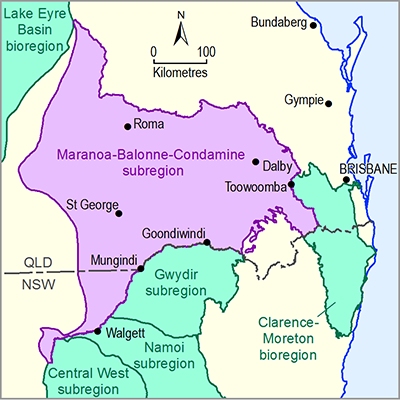The ‘rule-out’ process is used to identify areas, and consequently water resources and water-dependent assets, that are very unlikely to experience hydrological change or impact due to additional coal resource development.
Firstly, the ‘preliminary assessment extent’ is defined for each subregion or bioregion. This is a conservative spatial boundary that includes the groundwater and surface water systems that may be affected by coal resource development in the subregion. The preliminary assessment extent (PAE) contains all water-dependent assets, landscape classes that summarise key surface ecosystems, and helps define the spatial extent of numerical surface water and/or groundwater models in the subregion. Hydrological modelling is used to finalise the ‘assessment extent’ used for the impact and risk analysis. The assessment extent used in this product is identical to the PAE identified in product 1.3 for the Maranoa-Balonne-Condamine subregion (Mitchell et al., 2015).
Hydrological modelling results are then used to define a zone to ‘rule out’ potential impacts. The zone of potential hydrological change is the area with at least a 5% chance of greater than 0.2 m drawdown due to additional coal resource development. This threshold matches state regulations to protect sensitive water-dependent landscapes and assets from adverse effects. Because surface water modelling was not undertaken for this subregion, groundwater hydrological changes alone were used to define the zone.
The zone is represented at the surface, or in the relevant geological layer from which water-dependent landscapes and assets source water. Water-dependent landscapes and assets outside of this zone are very unlikely to be impacted by hydrological changes due to additional coal resource development.

Product Finalisation date
- 3.1 Overview
- 3.2 Methods
- 3.3 Potential hydrological changes
- 3.4 Impacts on and risks to landscape classes
- 3.4.1 Overview
- 3.4.2 Landscape classes that are unlikely to be impacted
- 3.4.3 'Floodplain or lowland riverine (including non-GAB GDEs)' landscape group
- 3.4.4 'GAB GDEs (riverine, springs, floodplain or non-floodplain)' landscape group
- 3.4.5 'Non-floodplain or upland riverine (including non-GAB GDEs)' landscape group
- 3.4.6 'Human-modified' landscape group
- References
- Datasets
- 3.5 Impacts on and risks to water-dependent assets
- 3.6 Commentary for coal resource developments that are not modelled
- 3.7 Conclusion
- Citation
- Acknowledgements
- Contributors to the Technical Programme
- About this technical product
